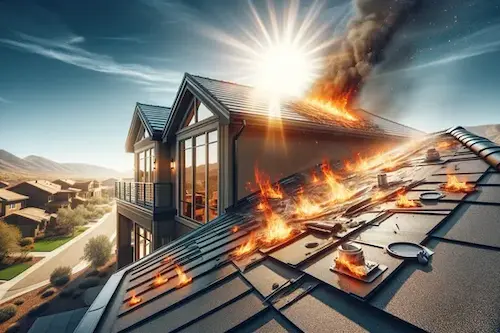Comparing fire-resistant roofing options for homes in high-risk areas

Homeowners in fire-prone regions must prioritize fire-resistant roofing to protect their properties from potential disasters.
Wildfires and accidental fires pose a significant threat, and choosing the right roofing material can make a critical difference in safeguarding your home.
In this article, we compare various fire-resistant roofing options based on fire ratings, durability, cost, and environmental impact to help you make an informed decision.
Understanding Fire Ratings for Roofing Materials
Roofing materials are classified into different fire resistance categories based on their ability to withstand flames and prevent the spread of fire. These categories include:
- Class A: The highest level of fire resistance, offering excellent protection against fire exposure.
- Class B: Moderate fire resistance, but not as effective as Class A materials.
- Class C: The lowest level of fire resistance, offering minimal protection.
- Unrated: Materials that do not meet fire-resistance standards and should be avoided in high-risk areas.
Now, let’s examine some of the most effective fire-resistant roofing materials.
- Metal Roofing
Fire Rating: Class A
Durability: 40-70 years
Cost: Moderate to high ($5 to $15 per square foot)
Environmental Impact: Recyclable, energy-efficient, and often made from recycled materials.
Metal roofing is one of the best fire-resistant options for homes in high-risk areas. It is non-combustible and does not ignite even when exposed to intense flames. Additionally, metal roofs have excellent durability, resisting extreme weather conditions such as hail, wind, and rain. They are lightweight and require minimal maintenance, making them a practical long-term investment. However, metal roofs can be more expensive upfront compared to other materials.
- Concrete and Clay Tiles
Fire Rating: Class A
Durability: 50-100 years
Cost: High ($10 to $20 per square foot)
Environmental Impact: Sustainable, recyclable, and energy-efficient.
Concrete and clay tiles are highly fire-resistant, making them ideal for homes in wildfire-prone areas. These tiles are non-combustible and provide excellent thermal insulation, which can reduce energy costs. However, they are significantly heavier than other roofing materials and may require additional structural support. Installation and repairs can also be costly due to the weight and fragility of the tiles.
- Slate Roofing
Fire Rating: Class A
Durability: 75-150 years
Cost: Very high ($15 to $30 per square foot)
Environmental Impact: Natural, long-lasting, and recyclable.
Slate roofing is a premium fire-resistant option that offers superior durability and an elegant aesthetic. Being a natural stone material, it is completely fireproof and can withstand extreme temperatures. Slate roofs have one of the longest lifespans among all roofing materials, often lasting over a century. However, they are expensive and require a strong roof structure to support their weight.
- Asphalt Shingles (Fire-Resistant Varieties)
Fire Rating: Class A (for fiberglass-based shingles)
Durability: 20-30 years
Cost: Low to moderate ($1.50 to $5 per square foot)
Environmental Impact: Limited recyclability; some energy-efficient options available.
Standard asphalt shingles are not very fire-resistant, but fire-resistant varieties, such as fiberglass-based asphalt shingles, achieve a Class A fire rating. These shingles are more affordable than other fire-resistant options, making them a popular choice among homeowners. However, they have a shorter lifespan compared to metal or tile roofing and may require more frequent replacements.
- Composite Roofing
Fire Rating: Class A
Durability: 30-50 years
Cost: Moderate ($4 to $12 per square foot)
Environmental Impact: Many options are made from recycled materials.
Composite roofing is made from a blend of materials such as fiberglass, recycled plastics, and asphalt. Many composite shingles are engineered to be fire-resistant and can achieve a Class A rating. This type of roofing offers the aesthetic appeal of wood or slate without the fire hazards or weight concerns. Additionally, composite shingles are often more impact-resistant and durable than traditional asphalt shingles.
- Treated Wood Shakes (Fire-Retardant Coating)
Fire Rating: Class B or Class A (with proper treatment)
Durability: 30-50 years
Cost: High ($6 to $12 per square foot)
Environmental Impact: Renewable, biodegradable, but not as fire-resistant as other options.
Traditional wood shakes are highly flammable, making them unsuitable for fire-prone areas. However, fire-retardant-treated wood shakes can achieve a Class A rating. While these treated wood shakes provide better fire protection, they still do not match the safety levels of non-combustible materials like metal or concrete tiles. Additionally, they require regular maintenance to preserve their fire resistance and overall durability.
Factors to Consider When Choosing Fire-Resistant Roofing
When selecting the right fire-resistant roofing material, consider the following factors:
- Fire Rating: Always opt for a Class A fire-rated material for maximum protection.
- Durability and Maintenance: Choose a material that suits your maintenance preferences and longevity expectations.
- Cost: Consider both upfront costs and long-term savings, including insurance discounts for fire-resistant materials.
- Weight and Structural Requirements: Heavier materials like slate and tile may require additional structural support.
- Aesthetic Appeal: The roofing material should complement your home’s architectural style.
- Environmental Impact: Consider sustainable and recyclable materials to reduce your carbon footprint.
Investing in fire-resistant roofing is essential for homeowners in high-risk areas. Metal roofing, concrete and clay tiles, and slate roofs offer the best fire protection, while fire-resistant asphalt shingles and composite roofing provide cost-effective alternatives.
Carefully evaluate the fire rating, durability, cost, and environmental impact of each option to choose the best roofing material for your home.
By making an informed decision, you can enhance the safety and longevity of your property while ensuring peace of mind in the face of potential fire hazards.